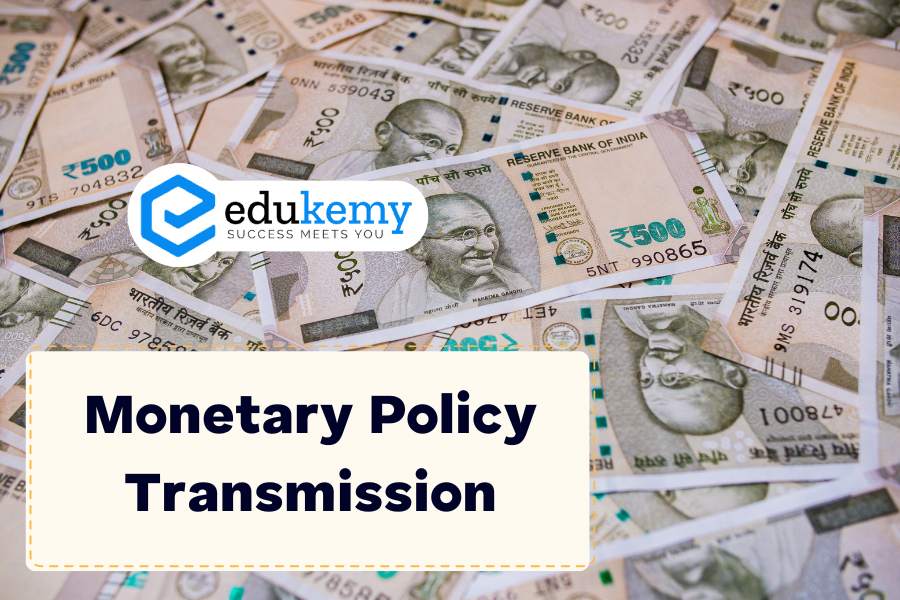
Monetary policy transmission refers to the process through which changes in monetary policy instruments, such as interest rates and reserve ratios, influence various economic variables, including demand, prices, credit availability, asset prices, and consumption. The effectiveness of monetary policy transmission is crucial for achieving the desired economic outcomes. Several factors impact the transmission mechanism:
- Availability of Data:
- Adequate and timely availability of economic data is essential for policymakers to make informed decisions and for the effective transmission of monetary policy.
- Reach of Financial Institutions:
- The effectiveness of monetary policy relies on the reach of financial institutions, particularly banks, in the economy. Financial inclusion becomes crucial, especially in countries with a large population that may be financially excluded.
- Banking Sector Health:
- The health of the banking sector plays a role. If banks are burdened with bad loans, they may be hesitant to pass on the benefits of rate reductions to borrowers, as they need to recover losses from non-performing assets.
- Government Fiscal Policies:
- Fiscal policies, such as loan waivers or changes in minimum support prices (MSP), can influence the transmission of monetary policy. Government actions that inject money into the market may affect inflation dynamics.
- Global Factors:
- External factors, including the monetary policies of major economies, global interest rate movements, and currency manipulations by other countries, can impact India’s monetary policy. Capital flows and exchange rates are sensitive to global conditions.
Contents
Measures to Enhance Monetary Policy Transmission:
- Deregulation of Savings Account Rate:
- Deregulating the savings account interest rate allows commercial banks to set their own rates, making the interest rate structure more flexible.
- Replacement of PLR with Base Rate and MCLR:
- The replacement of the Prime Lending Rate (PLR) with the Base Rate and later the Marginal Cost of Funds Based Lending Rate (MCLR) aimed to make lending rates more responsive to changes in policy rates.
- Incremental CRR Measures:
- Implementing measures like making incremental Cash Reserve Ratio (CRR) zero for loans to specific sectors, such as MSMEs, for a specified period, is designed to encourage lending to targeted segments.
- LTRO (Long-Term Repo Operations):
- Introduction of Long-Term Repo Operations (LTRO) is a tool used by central banks to provide longer-term liquidity to banks, thereby supporting credit flows to various sectors of the economy.
These measures are intended to improve the effectiveness of monetary policy transmission and ensure that changes in policy instruments lead to the desired outcomes in the real economy.
FAQs
Q: What is Monetary Policy Transmission?
A: Monetary policy transmission refers to the process through which central banks influence economic variables such as inflation, output, and employment by adjusting interest rates, money supply, and other monetary policy tools. The aim is to achieve macroeconomic objectives such as price stability and full employment.
Q: How does Monetary Policy Transmission Work?
A: Monetary policy affects the economy through various channels. One primary channel is the interest rate channel, where changes in central bank policy rates lead to corresponding changes in market interest rates, influencing borrowing costs for households and businesses. This, in turn, affects consumption, investment, and overall economic activity.
Q: What are the Channels of Monetary Policy Transmission?
A: The channels of monetary policy transmission include:
- Interest rate channel
- Credit channel
- Exchange rate channel
- Asset price channel
- Expectations channel
- Each channel operates through different mechanisms to influence economic variables and overall macroeconomic conditions.
Q: What are the Challenges in Monetary Policy Transmission?
A: Despite its importance, monetary policy transmission can face challenges, including:
- Transmission lags: There may be delays between changes in monetary policy and their effects on the economy.
- Imperfect transmission: Factors such as financial market frictions or asymmetrical information can hinder the smooth transmission of monetary policy.
- External shocks: Global economic developments, such as geopolitical events or financial crises, can complicate the transmission process.
Q: How do Central Banks Enhance Monetary Policy Transmission?
A: Central banks employ various strategies to enhance the effectiveness of monetary policy transmission, such as:
- Forward guidance: Communicating future policy intentions to influence market expectations.
- Non-conventional policy tools: Using unconventional measures like quantitative easing or asset purchases to directly influence specific financial markets.
- Macroprudential policies: Addressing financial stability risks to ensure a smoother transmission of monetary policy.
- Transparency and communication: Improving transparency and providing clear communication regarding policy decisions and objectives to enhance market predictability and understanding.
In case you still have your doubts, contact us on 9811333901.
For UPSC Prelims Resources, Click here
For Daily Updates and Study Material:
Join our Telegram Channel – Edukemy for IAS
- 1. Learn through Videos – here
- 2. Be Exam Ready by Practicing Daily MCQs – here
- 3. Daily Newsletter – Get all your Current Affairs Covered – here
- 4. Mains Answer Writing Practice – here

